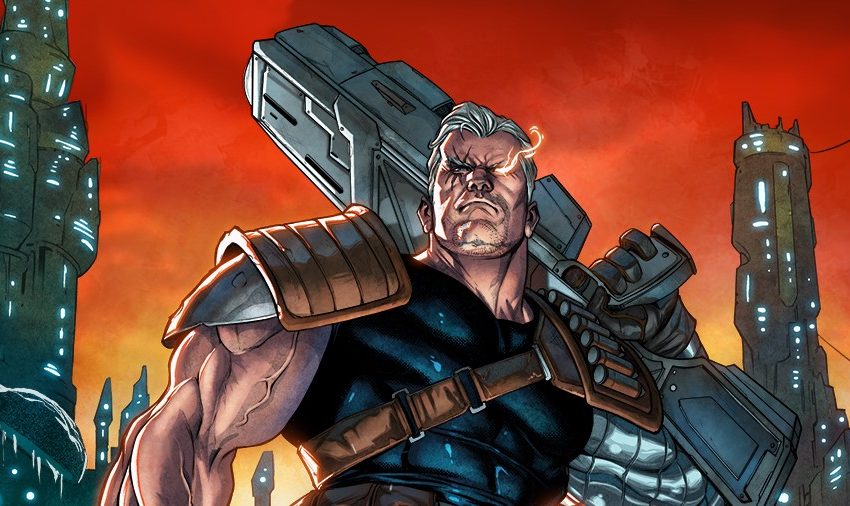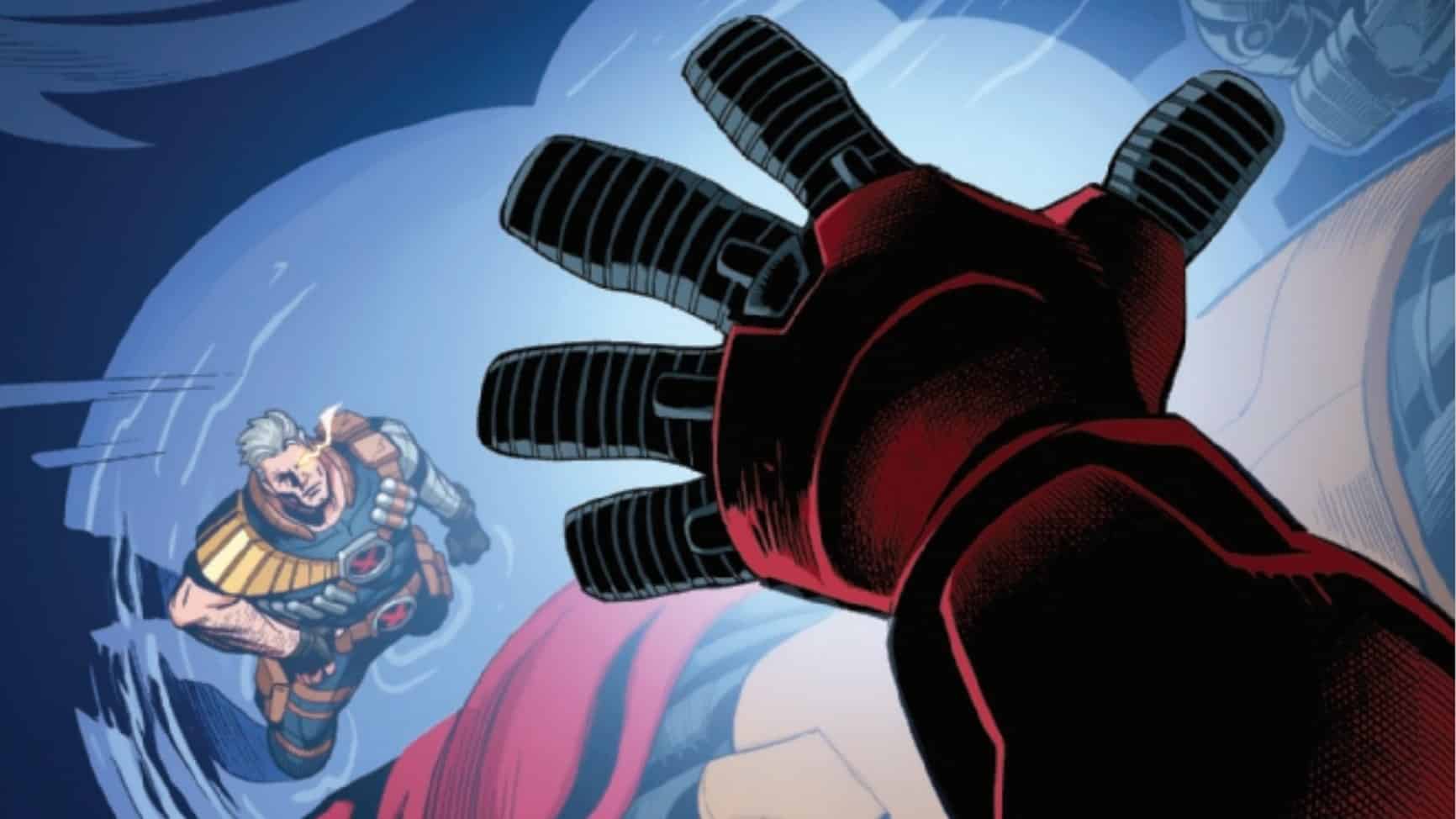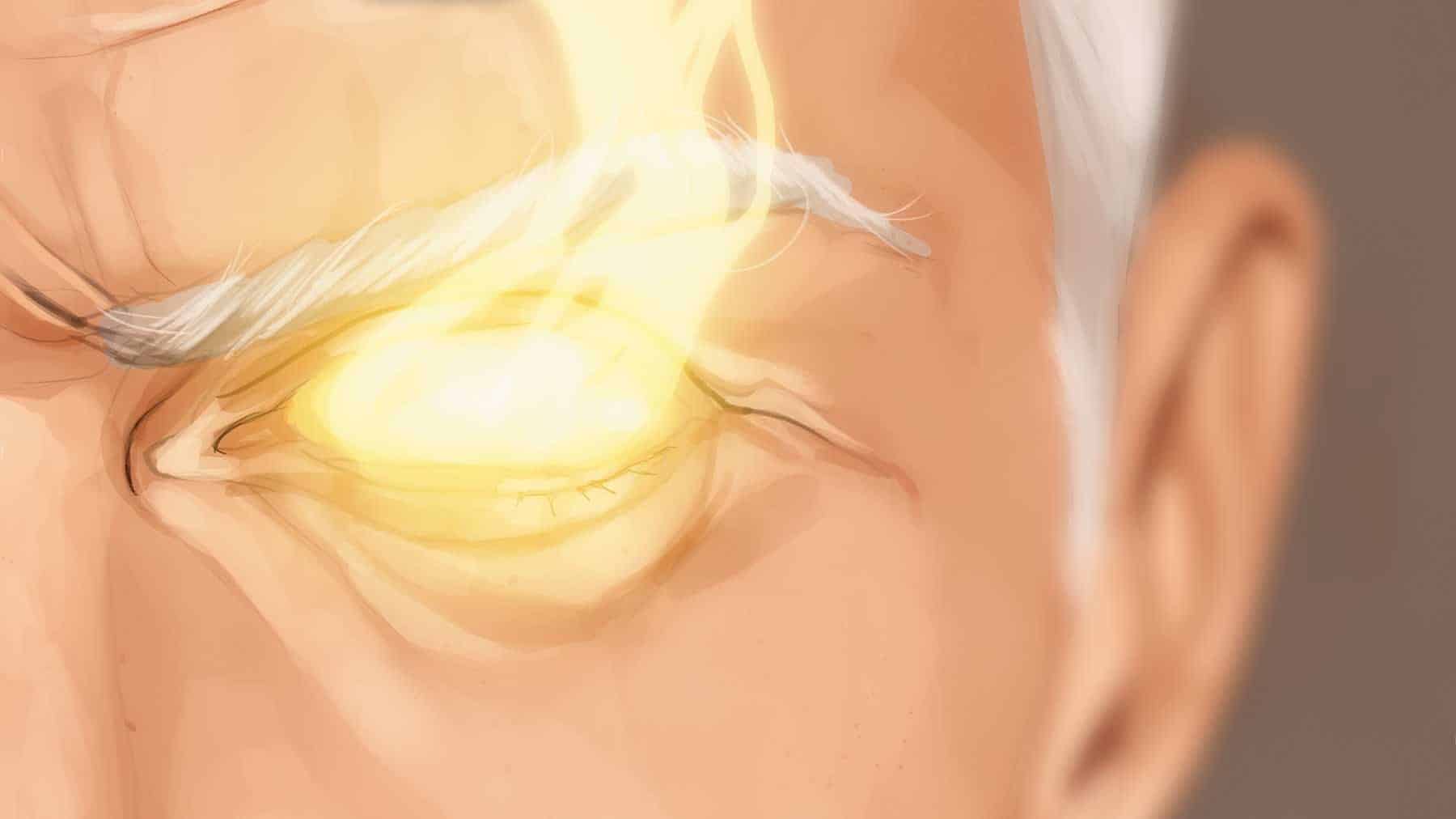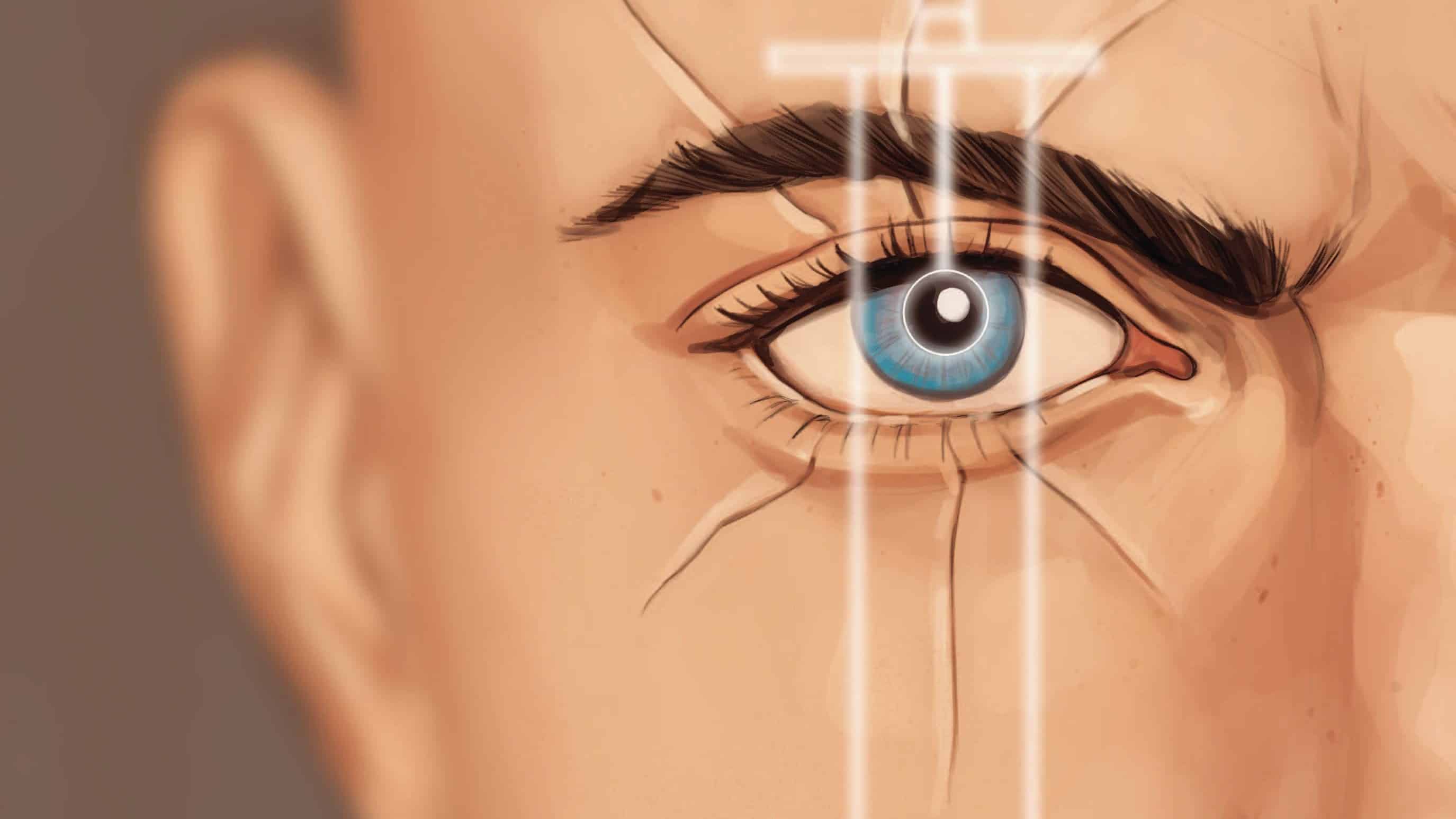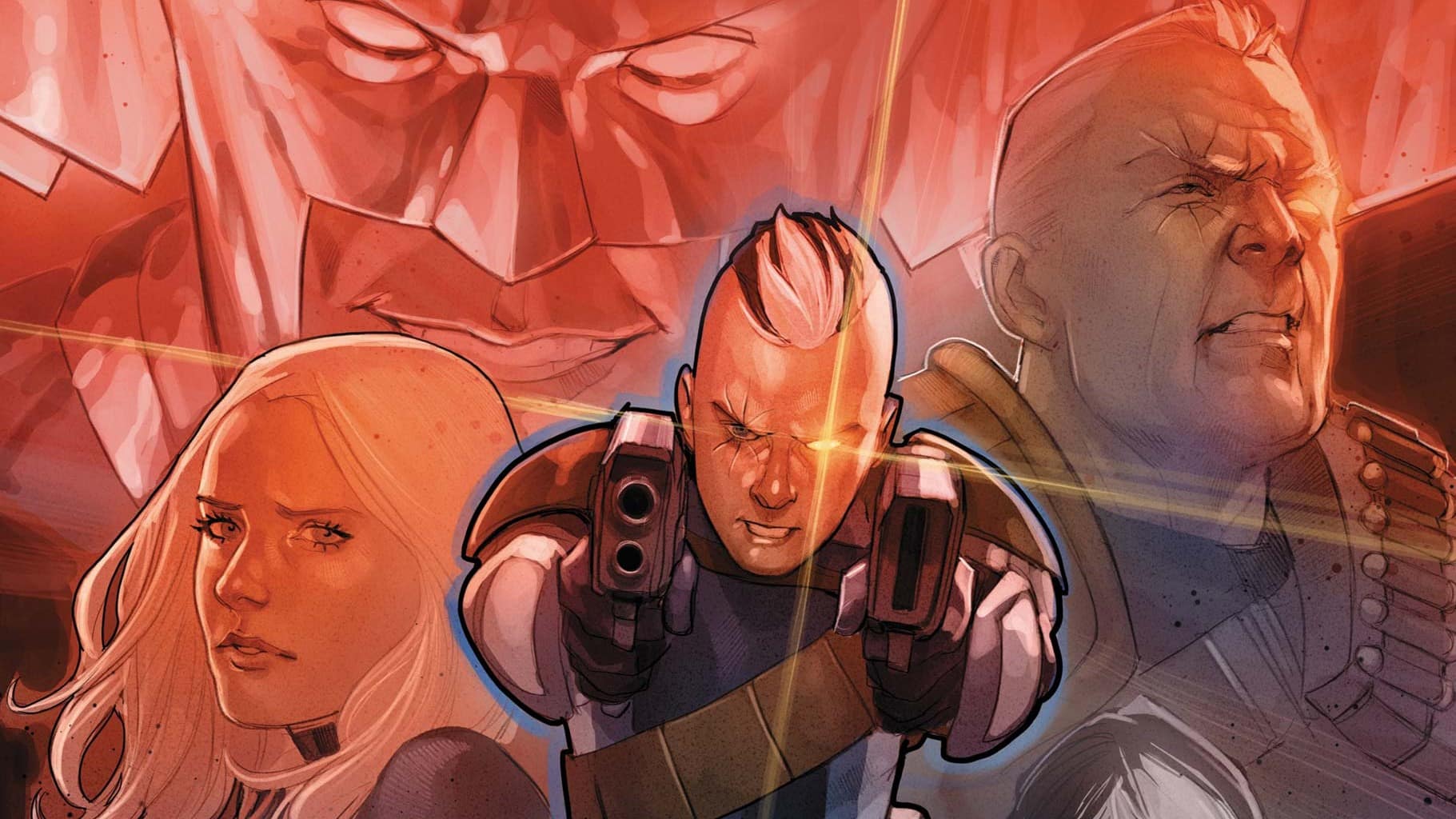As the dread lord Dormammu rages across the galaxy, the old man Cable steps into his role as head of security for SWORD. Now we see how the big guns take care of business in Cable: Reloaded #1 by Al Ewing, Bob Quinn, Java Tartaglia and Joe Sabino.
Ian Gregory: Okay, so I know I said two weeks ago that Cable was over, but it turns out Al Ewing and Bob Quinn have brought us a nice little dessert with this Last Annihilation tie-in one-shot. Vishal, you’re a fellow Cable enthusiast – or did you just read his entire solo series to punish yourself?
Vishal Gullapalli: I’m no stranger to reading whole comic runs to punish myself, but yeah I’m a HUGE Cable fan. I love the big guy and his big guns and the whole host of daddy issues he’s been saddled with. I can’t pretend I haven’t been antsy for months over Al Ewing writing one of my favorite characters, and I think this was definitely worth the wait.
The Old Man

Ian: Despite being a Cable solo entry, this is really an ensemble piece told from Cable’s perspective. We’ve got a cool mix of characters: Abigail Brand, Khora, and Wiz-Kid from SWORD, Rocket from Guardians, Cannonball and Boom-Boom from classic X-Force, and Lila Cheney, dragged from the depths of 1984. What makes these guests work is that Cable is feeding the reader his thoughts the entire time in a hilariously dry and jaded narration. Ewing uses this space to really expand what we know of Cable’s relationships with people, and tries to give everyone on the ad-hoc team their little moment. I think that Cable’s interactions with characters he hasn’t seen before – specifically Rocket and Khora – are the highlight of this team. How did you feel about this roster?
Vishal: My entire love of Cable comes from the early X-Force era with Cannonball, Boom-Boom, and co. So I was obviously delighted to see at least two of that team back with Cable for this mission. I completely agree about the highlights, though – Nathan’s reaction to Rocket is the exact kind of comedy that works for the character, something Ewing’s always been good at wringing out of any book he writes.
I really enjoy how he’s able to capture everyone’s individual quirks and relationships with each other in such a small window of opportunity. Pretty much immediately after they’re introduced, we get Khora’s bloodthirst, followed by Cannonball’s disapproval, followed by Cable’s pragmatism (laced with some idealism he acknowledges himself). Of course, it also helps that all of the guest stars have really cool powers. But something that really stuck with me was Cable expressing his admiration for Wiz Kid, and similarly Wiz Kid’s almost disdain for Cable. It’s a fascinating relationship, and one that could only exist in the weird time-travel experience that is the X-Men. Were there any other moments like that that caught your attention, Ian?
Ian: Most of the time with Cable, authors tend to forget that he’s… from the future. I know that sounds ridiculous, considering it’s his basic concept, but usually his time travel status is just an excuse for Cable to show up in the first place, and for him to have cool guns. What I like about this issue is that Ewing uses Cable’s future knowledge in more places than just the plot. Cable has opinions on characters he’s never met, based on things they haven’t done – but history isn’t perfect, as the man himself notes. These people can still disappoint Cable, or fail, and not live up to his future-knowledge. It allows Cable to feel more like a “man from the future” without sacrificing any narrative tension.
This issue is threaded with Cable’s hard-boiled narration. Modern comics have, criminally, moved away from the thought bubble, but I don’t think this issue works without our little glimpse into Cable’s head. It gives us the character introductions, power explanations, and fill-in bits of characterization all in Cable’s voice. The problem I often have with standard narrative captions is that they’re in perfectly neutral voice – no one in particular is saying them, and we aren’t getting anything other than exposition out of them. In this issue, half the character interactions are in Cable’s head – his approval of Khora’s instincts, his protectiveness towards Sam, his admiration of Taki. I think the narration is the glue that holds this team together, but still keeps it feeling like a Cable solo story.
Vishal: Something I also love is that these characters all have relationships with each other – they’re not defined by how they engage with Cable. The most obvious example is the exchange between Lila, Sam, and Boom-Boom where they all acknowledge and engage with their romantic histories together and all feel like people reminiscing about their pasts. Similarly, we get some good moments between Taki and Khora, as we learn more about our Arakkii guest and her world and get some nice moments of cultural appreciation. This is something that has made this Krakoa era feel strong under the pen of certain writers – these characters feel realized and complete rather than pieces on a great big puzzle, and the world feels more vibrant as a result.
Cable’s narration is, as you mentioned, the glue that holds this issue together. It’s essentially color commentary, making this standard superhero content feel important and meaningful. He provides continuity to all these callbacks that Ewing loves to pepper into his work, and he makes what would normally be goofy characters matter by affirming their importance in the future. We just haven’t seen them at their greatest.
Breakworld

Vishal: On those continuity callbacks, this issue does a pretty major one for its main story, bringing back the Breakworld from Joss Whedon’s Astonishing X-Men. I genuinely laughed when I got to it, because this was a concept I expected to fall by the wayside after Fraction’s wrap-up of its loose threads. Al Ewing never forgets, though. How’d the main story of this issue work for you?
Ian: Breakworld’s concept is thinner than the paper it’s printed on. Ewing takes the obvious turn towards comedy here, and thank goodness. The “data page” of Powerlord Varrn threatening his citizens to stay out of City Seven worked wonders for setting up what to expect on Breakworld, and got a good laugh out of me. I don’t really want or need actual, interesting developments on the Breakworld. So, sure, they just built themselves an even bigger gunner. Of course they did – they’re the Breakworld. If their new status in continuity is as the war-obsessed bone-headed aliens on the block, then that works just fine.
Ewing does take this idea for everything it’s worth. I get real joy out of any mech appearance [Ed. note: Ian, is it truly a mecha if it doesn’t have a pilot? Is that not just a big robot?], and this one worked very well – as did their mutant circuit-esque solution for defeating it. Breakworld is also a great choice to let Cable loose on because they’re unlikely to feature heavily into the events of SWORD, the main mutant cosmic feature. I appreciate what is essentially an exercise in excess: this crossover storyline is already about a minimum of six planets, so why not bring in another, completely unrelated planet? Cable’s a perfect fit for the general Breakworld aesthetic, too. Cable gets the universe’s biggest gun and biggest bullet, and I love that for him.
Vishal: The aesthetic is something I think Bob Quinn nails – with Java Tartaglia’s very orange colors, the comic brought a similar energy to a Rob Liefeld comic. And I don’t mean that as an insult, as bad as Liefeld’s art is. But something about the way Quinn draws Cable’s giant shoulders and Taki’s giant guns and Breakworld’s giant robot just makes this comic feel nostalgic.
The giant robot, though, that was some really cool stuff. I’m a sucker for when comics rotate 90 degrees to give height to their double-page spreads and this one worked wonders for me. I also really enjoy that Breakworld’s only development since their initial story was “do the same thing but bigger.” Er, metaphorically bigger, since the robot is smaller than the original Planet Gun. It’s an excess that fits Cable stories incredibly well.
Ian: I agree with your Liefeld comparison, and feel like I must immediately rush to qualify that comparison and say that it’s not a bad thing. I’m on the record as being minorly obsessed [Ed. note: Ian literally wrote the book on it] with Liefeld’s work, and Quinn evokes some of the highlights of his style – like some really clever layouts, great splashes, and good sense of movement – without the negatives (Quinn, for example, can render a variety of expressions). Phil Noto was good on Cable because it was a very atypical run of Cable, focusing more on comedy and character than action. Quinn feels like a good fit for this book because he can do good expressions and interactions but also has the raw intensity you expect from a Cable book.
What The Future Holds

Ian: One thing I didn’t like about this issue’s art, however, is the new Cable design. His costume is classic, but I don’t like the rework on his arm, which has more segmented components and lots of glowing lights. The solid light hologram was clever, but I’m still not sold on the combat tattoo gimmick we first saw with Belle. This is a minor gripe, though, since this issue does so much else to reintroduce Old Cable to modern continuity.
Vishal: I think the tattoos are part of a general direction by Ewing to make Cable likable by taking all the things people make fun of him for and dialing them up to 11. The monologues about pouches and guns, the big arms, adding a sailor’s tattoo only enhances that effect. Cable is the 90’s hero, but he’s aware of it and leans into it. That seems to be the pitch. It really does feel like Cable didn’t miss a beat after coming back, though – he’s ready to do his job the way he’s always done it.
Ian: I also like how much Ewing leaned into giving Cable his own sense of humor. I don’t think every character needs to be funny, in a Marvel movie kind of way, but Cable is just a goofy guy. He wears a big sack of pouches and has big guns and is overly dramatic. If you aren’t a super-mark for Cable like I am, you probably read him as silly anyway. I think his sense of humor around his guns and the deep sense of satisfaction he gets out of time travel (look at that smug grin) in meeting Rocket really will help non-Cable fans enjoy his stories.
I like that Ewing sets up that this Cable, despite being a couple of orders of magnitude more competent than Young Cable, still comes with his own issues. He doesn’t work very well with Abigail Brand, for instance, who has been up to her own shady agenda in SWORD. One side-effect of the Krakoa Era is that we have a preponderance of mutant leaders, from everywhere in the X-Men’s history. We’re seeing this play out in The Trial of Magneto as well, and a leadership or moral conflict with Brand in SWORD would make perfect sense. Cable is the perfect soldier, willing to do anything to complete the mission, but this issue highlights what a soft spot he’s developed for other mutants – and even his enemies.
Vishal: Something that Old Cable said at the end of Duggan’s run was that the Krakoa Era didn’t fix the world permanently, it didn’t stop his future from happening. But it made things better. That’s been Cable’s entire MO since The Twelve ended and his initial prophecy was complete – making the future better by changing the present. It was literalized in different ways between Cable and Deadpool and Si Spurrier’s X-Force, but the motivation has remained the same. And Ewing restates that goal here, in the simplest terms possible: “That’s what I’ve always fought for — a better tomorrow.”
There’s a lot of goofy stuff here, there’s a lot of stereotypical 90’s hero machismo, but this issue does an excellent job showcasing the heart underneath this hardened exterior. In moments like Cable’s genuine relief seeing Sam unharmed, in his narration showcasing an understanding that he carries himself as gruffer than he truly is, it’s good to have a book that gets into Old Cable’s head and makes it clear that he’s putting on an act. Cable has a clear place in this new era of the X-Men. He’s the one who knows it won’t last, but will fight tooth and nail to make sure its effects do.
Ian: This is an excellent one-shot, and I say that as someone with zero context on the cosmic / Guardians of the Galaxy aspect of things. This is essentially a stealth SWORD issue, and I like that Ewing took this opportunity to show off what Cable will be like going forward. The emphasis on history, and Cable’s perception of history, read as especially important and resonated with me. I’m always craving authors engaging more with Cable’s actual character concepts, and his unique view of history and Krakoa gives him an interesting contrasting viewpoint to the dozens of other mutants appearing in comics right now. Definitely check this one out.
X-Traneous Thoughts

- “A more compact model… but I think you’ll find it stands up” is a terrible and amazing and beautiful one-liner about Gun Mech
- Yes, I did want to see Boom-Boom use a Spirit Bomb on a giant robot, how did you know?
- Ewing really likes to mention that Sam’s nigh-invulnerable when he’s blastin’. And with good reason.
- It’s official: Cannonball is a wife guy.
- Krakoan Reads: WICCAN AND HULKLING

